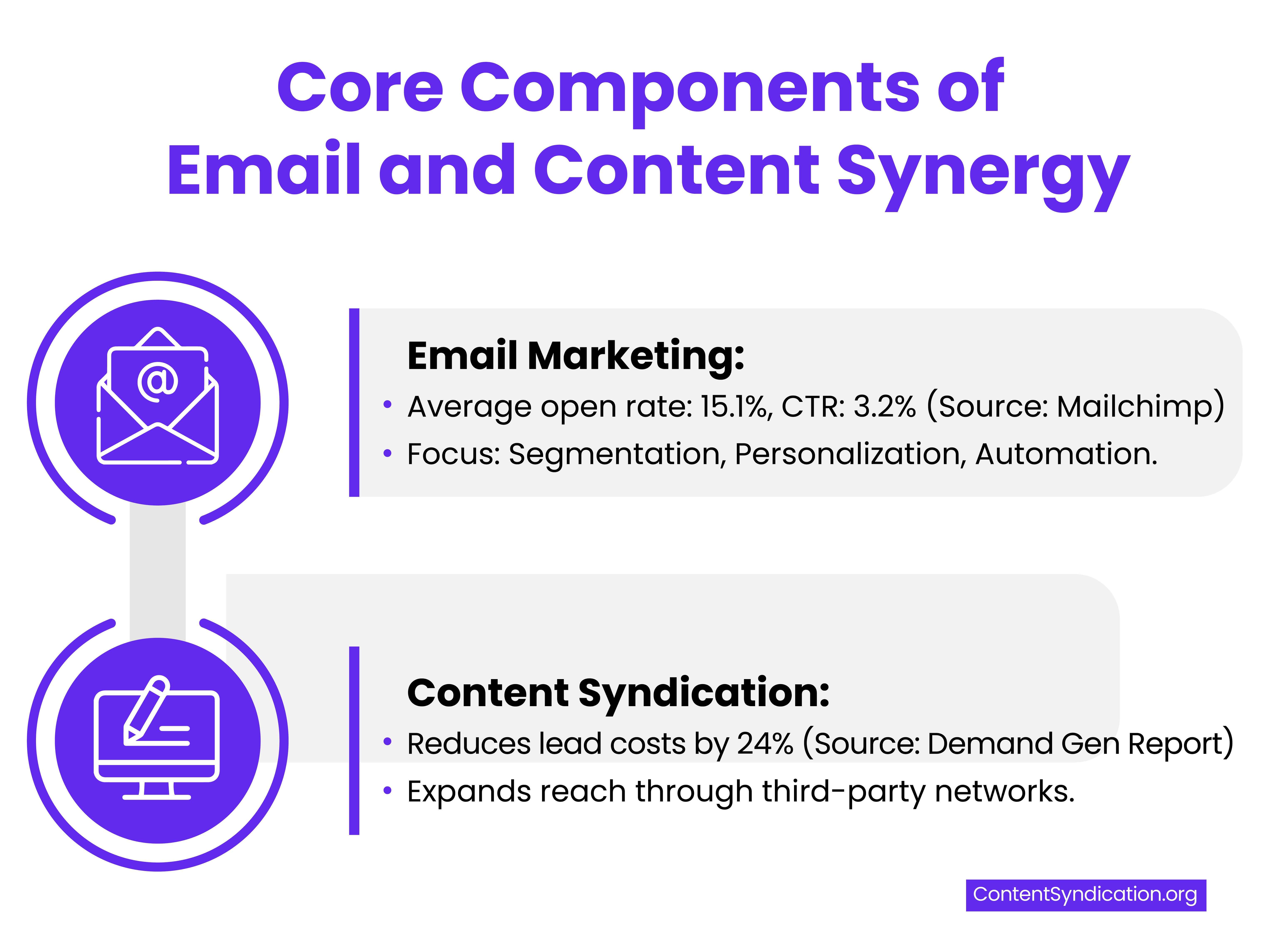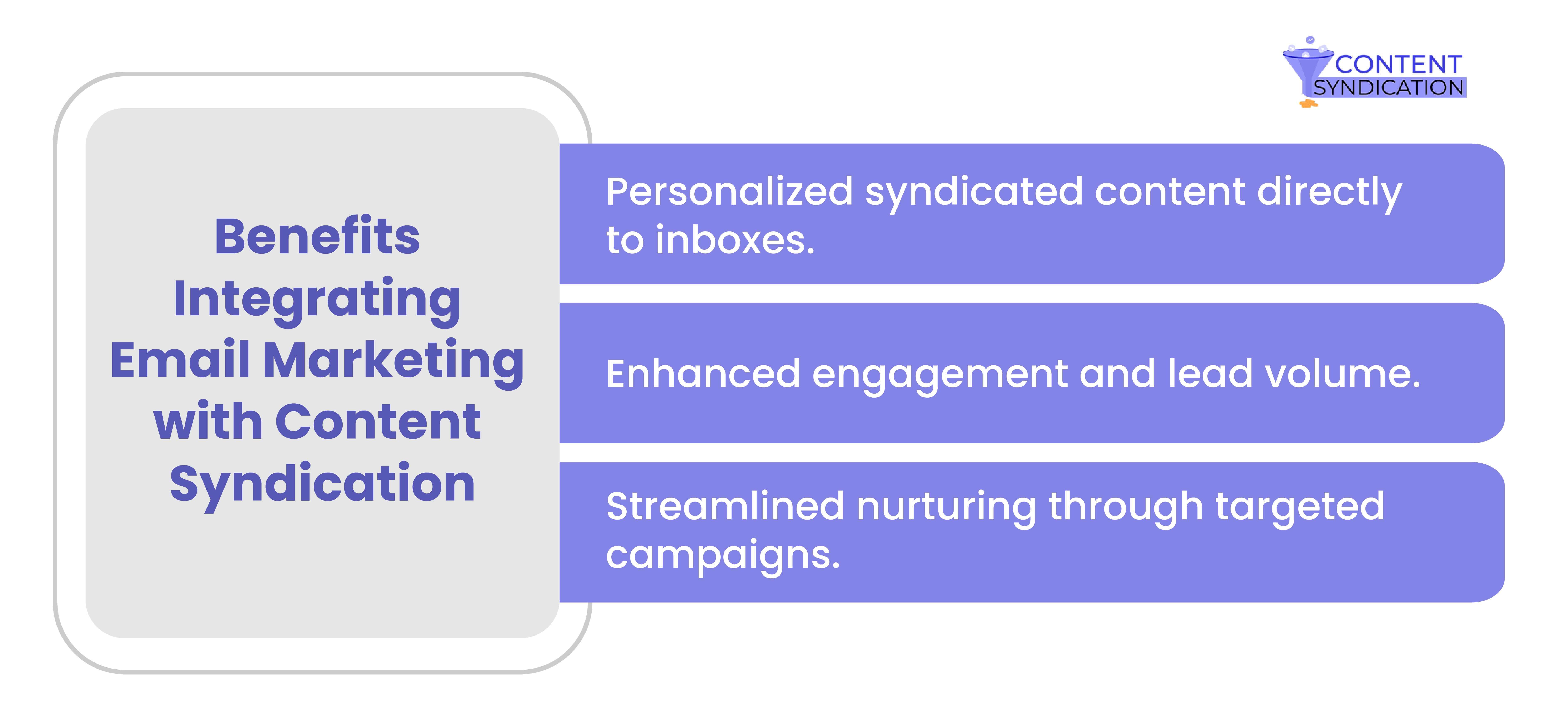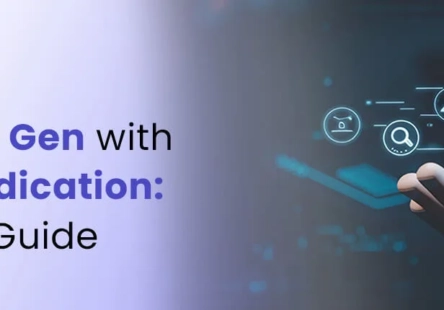Your audience is inundated with countless emails every day. With overflowing inboxes and shrinking attention spans, generic marketing emails have become mere background noise. And your customers? They crave genuine value and relevant insights.
The challenge? Standing out amidst the noise. The answer? Strategically combining email marketing with B2B content syndication.
When used together, these tools can elevate your marketing efforts. How? Personalized, high-quality content is the golden ticket to better email performance. When such messages land directly in the inboxes of your target audience, you forge stronger connections and drive real engagement.
So, if you’re ready to move beyond the one-size-fits-all approach and create marketing campaigns that resonate on a deeper level, you’re in the right place.
Let’s explore how combining email marketing with content syndication can transform your B2B strategy.
Understanding Email Marketing in B2B
Email marketing is the cornerstone of B2B communication, known for its ability to build strong connections, drive conversions, and maintain a consistent dialogue with prospects and clients.
According to recent benchmarks, B2B email marketing sees an average open rate of around 15.1% and a click-through rate of about 3.2%. These rates can vary by industry and campaign type. (Source: Mailchimp)
Unlike B2C email marketing, B2B email marketing is laser-focused, designed to address specific business needs and challenges.
But what gives life to these emails?
Key Components of B2B Email Marketing you need to know

Segmentation and Targeting:
Segmenting your email list lets you craft content that is more relevant to your recipients.
By dividing your audience—by industry, by size, by role—you make sure that each word, each message, lands where it is meant to.
But beware, for in the pursuit of precision lies the danger of over-segmentation — it can backfire by complicating campaigns.
So instead of creating too many granular segments, focus on a few key segments that have the highest impact on your business goals. This approach makes your campaigns more manageable and allows you to deliver targeted content without overcomplicating the process.
Personalization:
Do not be content with the surface. Dive deeper. Personalization allows you to connect with your audience on a more personal level. How? By addressing specific pain points or opportunities that your recipients face, you add value to their inbox.
This helps build trust and strengthens the relationship between your brand and the recipient.
But like all fine things, personalization takes time—it demands effort. And so, automation becomes your ally, your tool to scale without losing the personalized touch.
Begin with the simplest gestures: a subject line that speaks directly to them, content that reflects their journey.
You can also use dynamic content blocks that automatically adjust based on the recipient’s data, allowing for high-level personalization without requiring massive manual effort.
Automation and Drip Campaigns
To automate is to free yourself from the mundane, to allow your creativity to soar.
Drip campaigns make this easier by delivering timely, relevant content based on recipient interactions.
These campaigns, which send a series of emails triggered by recipient actions, are particularly effective in guiding prospects through the buyer’s journey.
Lead Nurturing
The journey of a sale is long, winding, and often fraught with obstacles. But lead nurturing steadily guides your prospect, offering them educational content, case studies, and personalized offers.
In their moments of doubt, your emails are the reminder that your brand is ever-present, ever-ready to meet their needs- ultimately progressing prospect through the sales funnel.
Analytics and Optimization
Intuition won’t take you far, but real data will. Data analytics informs you of what works, of what fails, and of what lies ahead.
But the deluge of data can overwhelm.
Focus on what matters—conversion rates, click-through rate; the metrics that guide buyers to conversion. And let automation carry the burden of data collection, freeing you to do what you do best: strategize, create, and innovate.
Exploring B2B Content Syndication
Content syndication involves distributing your content across a network of third-party websites, blogs, and platforms, expanding your reach and connecting with a broader audience.
According to Demand Gen Report, Content syndication is reported to reduce the cost per lead by an average of 24% compared to other lead generation strategies. (Source: Demand Gen Report)
For B2B marketers, this is a strategic way to build brand awareness and attract high-quality leads. By placing your content where your target audience already is, you increase the chances of connecting with decision-makers who are actively seeking solutions.
How Content Syndication Networks Work
Content syndication networks act as intermediaries, linking B2B marketers with a network of relevant platforms. These networks distribute your content—whether it’s whitepapers, eBooks, webinars, or articles–across multiple channels, ensuring it reaches a wider yet still targeted audience.
For example, a technology company might syndicate a whitepaper on cybersecurity across various IT-focused websites. This not only boosts content visibility but also drives traffic from prospects already engaged with the topic.
The Significance of Content Syndication in Expanding Reach and Driving Leads
Content syndication is particularly valuable in B2B marketing because it allows you to extend your reach beyond your own channels. It’s a cost-effective way to attract leads who are more likely to be interested in your offerings.
Additionally, syndicated content often ranks well in search engines, enhancing your visibility and authority in your industry. Generating backlinks through syndication also bolsters your website’s SEO, driving organic traffic.
The Synergy Between Email Marketing and Syndicated Content
While content syndication and email marketing are powerful tools on their own, combining them can yield spectacular results.
Imagine personalized syndicated content landing directly in the inboxes of your potential audience. It’s a perfect match. When you leverage this synergy, you’ll reach a highly targeted audience and increase lead volume.
Enhancing Email Marketing with Syndicated Content
Who wouldn’t want to deliver valuable blog posts, infographics, or videos to the right audience? Email marketing; The best way- where you can drop content directly into your audience’s inboxes.
Email marketing tactics like cold outreach and newsletter series work perfectly to complement your content syndication efforts.
For example, a company syndicating a new eBook on digital transformation can use excerpts or summaries in their email campaigns, encouraging recipients to download the full version. This not only adds value but also drives traffic back to the syndicated content.
Nurturing Syndicated Leads Through Email Marketing
Leads generated through content syndication are often in the early stages of the buyer’s journey.
While they’ve shown interest in your content, they need further nurturing to move toward a purchase. Email marketing is the perfect tool for this.
By enrolling syndicated leads into targeted nurturing campaigns, you can guide them through the sales funnel.
For instance, after a prospect downloads a syndicated whitepaper, you can follow up with a series of emails that delve deeper into the topic, offer additional resources, and ultimately lead to a consultation or demo request.
Challenges of Email Marketing for B2B Content Syndication
Email is powerful, but it comes with challenges. Deliverability can be affected by spam filters, personalization must be balanced with privacy, and proving ROI is often harder than expected.
- Deliverability and Spam Filters – Getting into the inbox is not guaranteed. Technical setup and reputation management are key.
- Balancing Personalization with Privacy – Marketers must personalize without overstepping boundaries.
- Measuring ROI – Open and click rates aren’t enough; real ROI comes from leads and sales.
Best Practices for Integrating Email Marketing with Content Syndication

To maximize the benefits, follow these best practices:
Align Content Syndication Efforts with Email Marketing Goals
Clearly define your goals for both email marketing and content syndication efforts. Whether your objective is to generate leads, increase brand awareness, or drive conversions, ensure that your content syndication strategy aligns with these goals.
For instance, if your primary goal is lead generation, focus on syndicating content that addresses your prospects’ common challenges.
Personalize Syndicated Content for Email Campaigns
Maximize the effectiveness of your email campaigns by personalizing content according to each recipient’s interests and behavior.
Segment your email list based on factors such as the type of content they’ve downloaded, their industry, or their position in the sales funnel.
Personalization boosts engagement and helps build trust, strengthening relationships with your audience.
Track and Analyze Performance Metrics
The success of your integrated strategy depends on your ability to monitor and analyze key performance metrics.
Track indicators like lead quality, email open rates, click-through rates, and conversions. Use this data to refine your strategy, making necessary adjustments to continually improve your outcomes.
AI + Email in B2B Content Syndication
Artificial intelligence is changing the way B2B marketers use email alongside content syndication. AI tools analyze intent data, behavioral signals, and engagement patterns to segment audiences more effectively. They can predict the best time to send, personalize subject lines, and even recommend content formats most likely to resonate with each lead.
For marketers, this means higher open rates, stronger click-throughs, and more qualified leads entering the pipeline. When combined with content syndication, AI-powered email ensures your brand’s message reaches not just more inboxes, but the right inboxes at the right time.
Measuring ROI of Email + Syndication Campaigns
One of the biggest challenges in B2B marketing is proving ROI. When email and syndication are combined, the key is to measure outcomes beyond vanity metrics.
Open rates and CTR are useful, but the true indicators are cost per lead (CPL), lead-to-MQL conversion, sales pipeline velocity, and contribution to closed-won deals.
By connecting email campaign data with syndicated content performance, marketers can see how both channels reinforce each other. This holistic view makes it easier to justify budgets, optimize campaigns, and prove marketing’s impact on revenue.
Email + ABM Integration for Smarter Outreach
Account Based Marketing (ABM) thrives on precision, and combining it with email + syndication is a powerful strategy.
Content syndication ensures decision-makers within target accounts see relevant thought leadership, while email delivers follow-up nurturing sequences tailored to each stage of the buying journey.
Together, they move accounts through the funnel more efficiently. For example, after a prospect engages with syndicated content, a personalized email sequence can guide them toward booking a sales call.
This integration ensures marketing spend is focused on accounts most likely to convert, driving better ROI and sales alignment.
Conclusion: Why Email Complements Content Syndication
In B2B marketing, combining email marketing with content syndication is a powerful strategy. Email marketing allows you to deliver personalized messages directly to your audience, while content syndication broadens your reach by placing your content on relevant third-party platforms.
When these two strategies work together, they don’t just coexist—they boost each other.
Using email to share syndicated content ensures your messages are both relevant and backed by the credibility of external sites, leading to higher engagement and conversions.
To stay ahead, view email marketing and content syndication as complementary strategies. Together, they can elevate your brand, drive better results, and position you as a leader in your industry.
Frequently Asked Questions (FAQs)
How do email marketing and content syndication work together in B2B?
Email marketing and content syndication complement each other by:
- Email: Delivering personalized content directly to your audience’s inbox.
- Syndication: Placing that content on high-authority third-party platforms to attract new, top-of-funnel leads.
Together, they expand your reach while nurturing leads through a targeted email strategy.
Can syndicated content be reused in email marketing?
Yes. You can:
- Repurpose syndicated content (like whitepapers or blog posts) as email series.
- Share summaries or key insights from syndicated eBooks.
- Include CTAs to full syndicated content to drive engagement.
This boosts the ROI of your content and keeps your emails value-driven.
What types of content work best for syndication + email campaigns?
High-performing content includes:
- Whitepapers and eBooks: Great for lead magnets.
- Webinars: Useful for deeper engagement.
- Case studies and success stories: Effective in nurturing.
- Checklists or infographics: Easy to digest and share via email.
Are syndicated leads suitable for email nurturing?
Yes, but with care. Syndicated leads are often top-of-funnel, meaning they’ve shown interest but aren’t ready to buy. Email nurturing helps by:
- Educating them about their problem and your solution
- Providing targeted value through segmented campaigns
- Progressing them through the funnel with personalized follow-ups
How should I segment syndicated leads for email marketing?
Segment by:
- Content downloaded (e.g., cybersecurity vs. cloud migration)
- Industry or job role
- Engagement behavior (clicks, time on page, etc.)
This allows you to send relevant content at the right time, boosting open and click-through rates.
Should I automate emails for syndicated leads?
Absolutely. Use drip campaigns to automate nurturing workflows:
- Day 1: Thank-you + summary of downloaded content
- Day 3–7: Follow-up with related content
- Week 2–3: Invite to webinar, product tour, or demo
This automation ensures timely engagement while freeing up your team.
What are the best platforms for syndication-driven email campaigns?
For email:
- HubSpot, Mailchimp, ActiveCampaign
For syndication: - Outbrain, Taboola, NetLine, TechTarget
Some marketing platforms offer combined tools for managing leads from syndication to email nurturing.
How can I measure the success of integrated email + syndication efforts?
Track:
- Open rate & CTR (email effectiveness)
- Lead quality & funnel stage progression
- Conversion rate from email CTA to final offer (e.g., demo)
- ROI & cost per lead (overall campaign efficiency)
Use these metrics to optimize content formats, timing, and targeting.
How do I avoid spam complaints when emailing syndicated leads?
- Always use opt-in or permission-based lists.
- Clearly identify yourself in the email.
- Include easy unsubscribe options.
- Warm up your relationship first with educational content—don’t pitch immediately.
What’s the biggest mistake marketers make when combining email and syndication?
- Misalignment of goals: Treating the two as separate efforts.
- Lack of segmentation: Sending generic emails to all leads.
- No follow-up: Failing to nurture syndicated leads beyond the first email.
Ensure both strategies are integrated, with shared goals, segmented messaging, and consistent nurturing.




